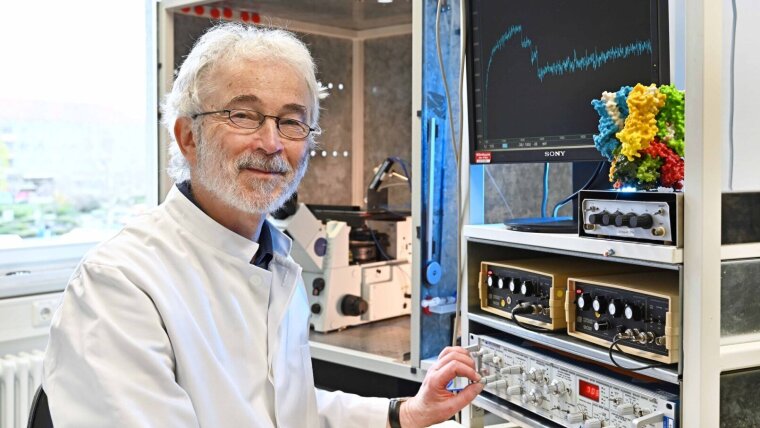
- Research
Published: | By: Uta von der Gönna
Physiologists at Jena University Hospital have used single-channel measurements to investigate the conductivity of pacemaker ion channels, which control the rhythmic activity of nerve or heart muscle cells. They show that this is characteristic of the four channel types and, together with biophysicists from Berlin, explain the causes of the specific conductivities at the molecular level. This functional differentiability offers an approach for targeting specific channels with active substances.
Ion channels are not rigid openings through which potassium or sodium ions pass the cell membrane. Like cat flaps or car doors, they have different sizes, opening mechanisms and permeability. If necessary, the cell can also form new ion channels or degrade those that are not required. The channels consist of protein molecules in the cell membrane that change their shape through voltage differences or the docking of suitable messenger molecules so that they can allow ions to pass through. Pacemaker ion channels control the rhythmic activity of specific cells, for example the contraction of heart muscle cells and the resting rhythm of certain nerve cells in deep sleep. Like the unrest in a pendulum clock, an interplay of charge separation and charge equalisation in the cells triggers vital processes in the heart and brain. This makes these ion channels extremely interesting targets for specific active substances.
The channels each consist of four protein building blocks, of which there are four different ones. Prof. Dr Klaus Benndorf's research group|working group|study group|task force investigated in detail how the differently structured pacemaker channels work. "There are only a few studies on the conductivity of pacemaker channels in the literature, with very different and sometimes implausible values," says the Director of the Institute of Physiology II at Jena University Hospital. This was the reason for measuring ion currents through individual channels, which consist of either the same or different subunits.
The conductance values are exceptionally small
To do this, he used a patch-clamp measuring station to investigate the current flow through pieces of the cell membrane of frog eggs that are less than a thousandth of a square millimetre in size. The production of channel molecules of a certain type had previously been genetically stimulated in these. If the measured current traces showed only two amplitudes, the piece of membrane contained exactly one channel - either open or closed. This allowed the conductivity for the specific channel to be determined very precisely. "The conductance values are exceptionally small compared to most other ion channels, they are around one picosiemens and below," says Klaus Benndorf about the result. "They were long considered barely measurable. Surprisingly, the conductivities now determined differ up to threefold between the channel types, so they are very specific to the respective pacemaker channel." The conductance values of the mixed forms lie in between.
These differences in conductivity are not given reasons by the constrictions of the channel pore, as the biophysicist Prof Dr Han Sun from the Leibniz-Forschungsinstitut für Molekulare Pharmakologie in Berlin was able to show in subsequent molecular dynamic simulations. Rather, negative charges in the outer area of the channels are responsible for this, which increasingly lead the positively charged potassium ions into the channel pore. Klaus Benndorf: "These measurements provide us with an instrument to differentiate between the channels of this clinically very relevant channel class in the tissue. This is an essential requirement for the development of tissue-specific drugs."
Original publication:
K. Benndorf et al: Subunit-specific conductance of single homomeric and heteromeric HCN pacemaker channels at femtosiemens resolution, Proc. Natl. Acad. Sci. U.S.A. 122 (5) e2422533122, https://doi.org/10.1073/pnas.2422533122External link
Am Klinikum 1
07747 Jena Google Maps site planExternal link